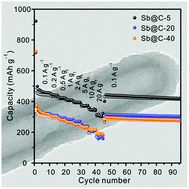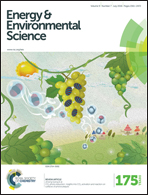Sb@C coaxial nanotubes as a superior long-life and high-rate anode for sodium ion batteries†
Abstract
Antimony (Sb) is an attractive anode material for sodium-ion batteries (SIBs) with a high theoretical capacity of 660 mAh g−1. However, its practical application is greatly hindered by the rapid capacity fading which is largely due to the large volume expansion during sodiation. Tuning the morphology and structure at the nanoscale or using carbonaceous materials as the buffer layer is essential to address this issue. Here, a facile carbon-coating coupled with a thermal-reduction strategy has been developed to synthesize unique Sb@C coaxial nanotubes. With different annealing time, the hollow space and the amount of Sb inside the tube can be easily tuned by the partial evaporation of Sb. The as-obtained Sb@C nanotubes exhibit excellent sodium storage properties. The remarkable electrochemical performance results from the unique coaxial nanoarchitecture. Specifically, it delivers a high specific capacity of 407 mAh g−1 at 100 mA g−1 after 240 cycles. Furthermore, a stable capacity of 240 mAh g−1 can be retained at 1.0 A g−1 even after 2000 cycles. Most importantly, high capacities of 350 mAh g−1 and 310 mAh g−1 can be achieved at large current densities of 10 and 20 A g−1, respectively, which represents the best rate performance among the reported Sb-based anode materials.


 Please wait while we load your content...
Please wait while we load your content...